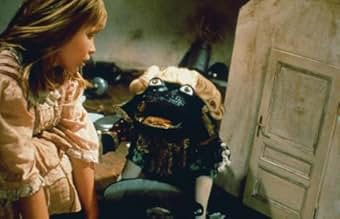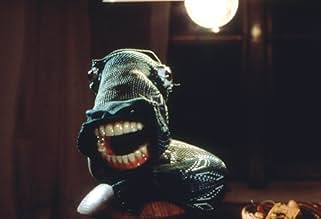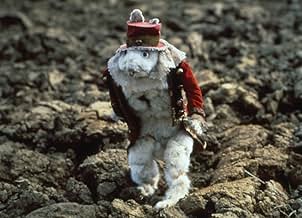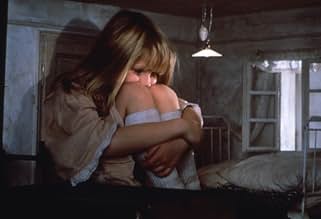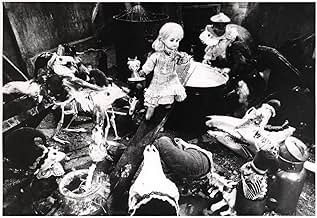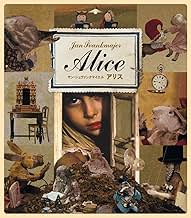Uma revisão surrealista de Alice no País das Maravilhas.Uma revisão surrealista de Alice no País das Maravilhas.Uma revisão surrealista de Alice no País das Maravilhas.
- Direção
- Roteiristas
- Artistas
- Direção
- Roteiristas
- Artistas
- Prêmios
- 1 vitória e 1 indicação no total
Camilla Power
- Alice
- (English version)
- (narração)
- Direção
- Roteiristas
- Elenco e equipe completos
- Produção, bilheteria e muito mais no IMDbPro
Avaliações em destaque
How best to interpret such a well-known classic in movie terms? Well, Jan Svankmajer, clearly an artist himself (a Czech version of Peter Greenaway) does it by extracting the essence of the book; the black humour and droll critique of Victorian society, investing it with his own rich surrealistic imagery. (Disney is not in the picture!)
Alice, played by a beautiful, doll-like girl, is energetic, brave and simple-minded, while her surroundings gradually go bonkers in ritual displays of nonsensical social custom. Svankmajer's celebrated mastery of dolls is on superb display, and dead objects, mostly worn, tattered and grotesquely animated, take on nightmarish properties. Foodstuffs certainly look repellent when sliding noisily across the kitchen-table!
The start of the movie is classic Svankmajer: Alice lies on the floor of her room, idly throwing pebbles into a half-empty tea-cup. (seen as a series of hypnotically repeated actions). The White Rabbit, here a stuffed specimen inside a glass display-cage, suddenly comes to life, puts on clothing hidden under the floor of his cage, cuts the wires that fasten his feet to the floor, breaks the glass, and he's off!
Svankmajer's "Alice" is the only version that comes close to rendering what Lewis Carroll's book is all about. It's a top notch art-movie for discerning audiences.
Alice, played by a beautiful, doll-like girl, is energetic, brave and simple-minded, while her surroundings gradually go bonkers in ritual displays of nonsensical social custom. Svankmajer's celebrated mastery of dolls is on superb display, and dead objects, mostly worn, tattered and grotesquely animated, take on nightmarish properties. Foodstuffs certainly look repellent when sliding noisily across the kitchen-table!
The start of the movie is classic Svankmajer: Alice lies on the floor of her room, idly throwing pebbles into a half-empty tea-cup. (seen as a series of hypnotically repeated actions). The White Rabbit, here a stuffed specimen inside a glass display-cage, suddenly comes to life, puts on clothing hidden under the floor of his cage, cuts the wires that fasten his feet to the floor, breaks the glass, and he's off!
Svankmajer's "Alice" is the only version that comes close to rendering what Lewis Carroll's book is all about. It's a top notch art-movie for discerning audiences.
About five years ago, when I had just graduated from high school, a friend of mine who had been to college introduced me to the works of Jan Svankmajer. He had checked out a VHS copy of three short films, Darkness/Light/Darkness, Male Games, and The Death of Stalinism in Bohemia. All three of them were works of great genius, and I immediately stored Svankmajer's name in my vault. So it's sad that it took me all five of these years to see another one of his works. I had thought about buying his Faust back when DVDs were dirt-cheap (do you remember those happy days?), but had passed over it for something else. Now I finally found another one of his films, Alice, this one a feature, his adaptation of Lewis Carrol's Alice's Adventures of Wonderland. And, wow, this is one frightening little film, a mix of live-action (well, one little girl) and stop-motion animation of characters like the White Rabbit, the Mad Hatter, and the Queen of Hearts. Stop-motion animation has always looked creepy, and Sankmajer knows it. He also knows that dead animals are scary, and he incorporates their bones into his animation. It makes the whole film more visceral and surreal.
There are two parts of this film that deserve particular attention. 1) the soundtrack. There is no musical score, and the only music at all is the tiny piece that plays over the closing credits. No, by soundtrack I am referring to the sound effects, and they are absolutely amazing. 2) the setting.The original novel and the Disney film set the story in a bizarre forest. Sankmajer sets the story in a delapidated house, with rotting and filthy wooden beams everywhere, creaky doors, and old cabinets. The setting is what makes the film particularly creepy.
As for standout scenes, the caterpillar is pretty awesome. The very best scene, though, is definitely the tea party, with the Mad Hatter and March Hare. Svankmajer's conception of those two characters and of the tea party is truly inspired, and ranks among the best scenes in cinema, in my opinion.
So is it perfect? No. The idea to have Alice speak all the lines, and then show her lips speaking such words as: "The Mad Hatter said" every two minutes grows annoying quickly, and the film would perhaps have been a masterpiece had this flaw been avoided. It seems to be in there for adding time, and it's truly unfortunate. I also wish that Svankmajer would have hurried up the beginning of the film, so as to get to other great scenes in the novel. It takes a half hour before Alice gets into Wonderland, and that's the only time the film grows boring. Whatever. This is still a great film. 9/10.
There are two parts of this film that deserve particular attention. 1) the soundtrack. There is no musical score, and the only music at all is the tiny piece that plays over the closing credits. No, by soundtrack I am referring to the sound effects, and they are absolutely amazing. 2) the setting.The original novel and the Disney film set the story in a bizarre forest. Sankmajer sets the story in a delapidated house, with rotting and filthy wooden beams everywhere, creaky doors, and old cabinets. The setting is what makes the film particularly creepy.
As for standout scenes, the caterpillar is pretty awesome. The very best scene, though, is definitely the tea party, with the Mad Hatter and March Hare. Svankmajer's conception of those two characters and of the tea party is truly inspired, and ranks among the best scenes in cinema, in my opinion.
So is it perfect? No. The idea to have Alice speak all the lines, and then show her lips speaking such words as: "The Mad Hatter said" every two minutes grows annoying quickly, and the film would perhaps have been a masterpiece had this flaw been avoided. It seems to be in there for adding time, and it's truly unfortunate. I also wish that Svankmajer would have hurried up the beginning of the film, so as to get to other great scenes in the novel. It takes a half hour before Alice gets into Wonderland, and that's the only time the film grows boring. Whatever. This is still a great film. 9/10.
A mix of live action and stop-action, this arthouse flick is intriguing but bizarre. But if I was a little kid I'd be scared out of my wits by The White Rabbit with bulging glass eyeballs & long, hamster-like fangs. Socks become wood-eating worms, Alice starts eating marmalade full of tacks, a tiny mouse lands on her head, punctures it & starts a fire, the rabbit hole she falls down starts as a desk drawer that grabs her & draws her in. The Alice doll she becomes when she's shrunk is sweet but sad. I have to admit it's fascinating and 180 degrees from the saccharine sweetness of the Disney film. See it on video to experience something completely different, and probably more towards the way Lewis Carroll intended the story to be...
Animation legend Jan Svankmajer applies his distinctive style to Lewis Carroll's most famous creation, crafting one of the most original and unforgettable takes on Alice's adventures ever put to film. Having previously adapted Carroll in his 1971 short film, "Jabberwocky," Svankmajer returns to the author's work with this amazing feature-length film. Employing a magnificent blend of live action and stop-motion animation, he uses many of Carroll's ideas as jumping-off points. Many of the characters are reconstructed as nightmarish abstracts of the way they have usually been depicted in previous adaptions. The white rabbit is a stuffed real rabbit who keeps his watch tucked in a sawdust-leaking gap in his chest. The Dormouse has been reduced to a creepy crawling foxlike hide, and the Caterpillar is a sock with eyeballs and teeth that sews its eyes shut when it sleeps. Although familiar characters such as the Mock Turtle and the Cheshire Cat are left out, Svankmajer's film is incredibly faithful to the book's sense of fantasy and absurdity. The minimal dialogue and pronounced sound effects also add to the overall unsettling mood. The key to truly appreciating this version is to forget the common associated imagery from other adaptions, and treat this as its own entity. Just as a dream makes a totally different impression on you than a person you describe it to (regardless of how well you describe it), this film is one man's surreal interpretation of another man's surreal description. The skull-headed birds, walking dolls, and broken-down furniture of Svankmajer's world make this a pretty disturbing telling of Alice's journey, but a masterful, enthralling, and undeniably unique one as well.
The Alice books are one of the two richest works of literature yet produced. Of the best literature, Alice lends itself to cinematic reinterpretation. And this filmmaker has vision.
But Alice is a coherent work, following the 'apprentice' novel and having kabbalistic structure. This film is episodic, each episode conceived as a different world, connected only by doors. The stories establish an abstract world, a world of logic so pure that the weaknesses of logic are apparent. That's only in part attempted here.
Though in Czech, there is some dainty wordplay: Alice is messing about in her drawers. Initially, these contain drawing equipment, later scissors. The filmmakers' signature 'large person in small room' image is used here in the episode where 'Maryanne' (Alice plus her 'house) is attempted entry by Bill the lizard, Dodgson's image of sperm. Bill is mirrored later in the frog-footman, heavily phallic as is an introduced sequence where the feet themselves become penile, then advisory.
Svenkmajer understands the cards as Tarot, a seldom understood insight and adds a vignette of the March Hare and Hatter playing cards (almost certainly a nod to 'Seventh Seal'). There's some very good visual handling of inside/outside ambiguities, and stage/reality shifting -- this alone makes this project worth sharing. But aside from that, it seems that the magic of Alice's world has yet to be tapped by a filmmaker.
Note: in Carroll's vision, innocence trumps all: logic is seen as manmade and fallible. In this world confabulated reasoning threatens but no one really loses their head. Not so in Svenkmajer's bleak world. Heads really are lost. Innocence is at least dumbfounded and possibly unreal (those socks). Many heads are already decayed with only the skull remaining. Some beings are composed of empty skulls alone or with some ambulatory object. This is not a happy man, nor a world with any sunshine. I would not give these images to any child.
But Alice is a coherent work, following the 'apprentice' novel and having kabbalistic structure. This film is episodic, each episode conceived as a different world, connected only by doors. The stories establish an abstract world, a world of logic so pure that the weaknesses of logic are apparent. That's only in part attempted here.
Though in Czech, there is some dainty wordplay: Alice is messing about in her drawers. Initially, these contain drawing equipment, later scissors. The filmmakers' signature 'large person in small room' image is used here in the episode where 'Maryanne' (Alice plus her 'house) is attempted entry by Bill the lizard, Dodgson's image of sperm. Bill is mirrored later in the frog-footman, heavily phallic as is an introduced sequence where the feet themselves become penile, then advisory.
Svenkmajer understands the cards as Tarot, a seldom understood insight and adds a vignette of the March Hare and Hatter playing cards (almost certainly a nod to 'Seventh Seal'). There's some very good visual handling of inside/outside ambiguities, and stage/reality shifting -- this alone makes this project worth sharing. But aside from that, it seems that the magic of Alice's world has yet to be tapped by a filmmaker.
Note: in Carroll's vision, innocence trumps all: logic is seen as manmade and fallible. In this world confabulated reasoning threatens but no one really loses their head. Not so in Svenkmajer's bleak world. Heads really are lost. Innocence is at least dumbfounded and possibly unreal (those socks). Many heads are already decayed with only the skull remaining. Some beings are composed of empty skulls alone or with some ambulatory object. This is not a happy man, nor a world with any sunshine. I would not give these images to any child.
Você sabia?
- CuriosidadesDirector Jan Svankmajer had been disappointed by other adaptations of Carroll's book, which interpret it as a fairy tale. His aim was instead to make the story play out like an amoral dream.
- Erros de gravaçãoAfter testing the wooden mushroom fragments, Alice puts the piece that shrinks things in her right pocket and the other that enlarges things in the left one. In the next scene she encounters a tiny house and takes out the right hand fragment to enlarge it.
- ConexõesFeatured in Brows Held High: Alice (2011)
Principais escolhas
Faça login para avaliar e ver a lista de recomendações personalizadas
- How long is Alice?Fornecido pela Alexa
Detalhes
- Tempo de duração
- 1 h 26 min(86 min)
- Mixagem de som
- Proporção
- 1.37 : 1
Contribua para esta página
Sugerir uma alteração ou adicionar conteúdo ausente

